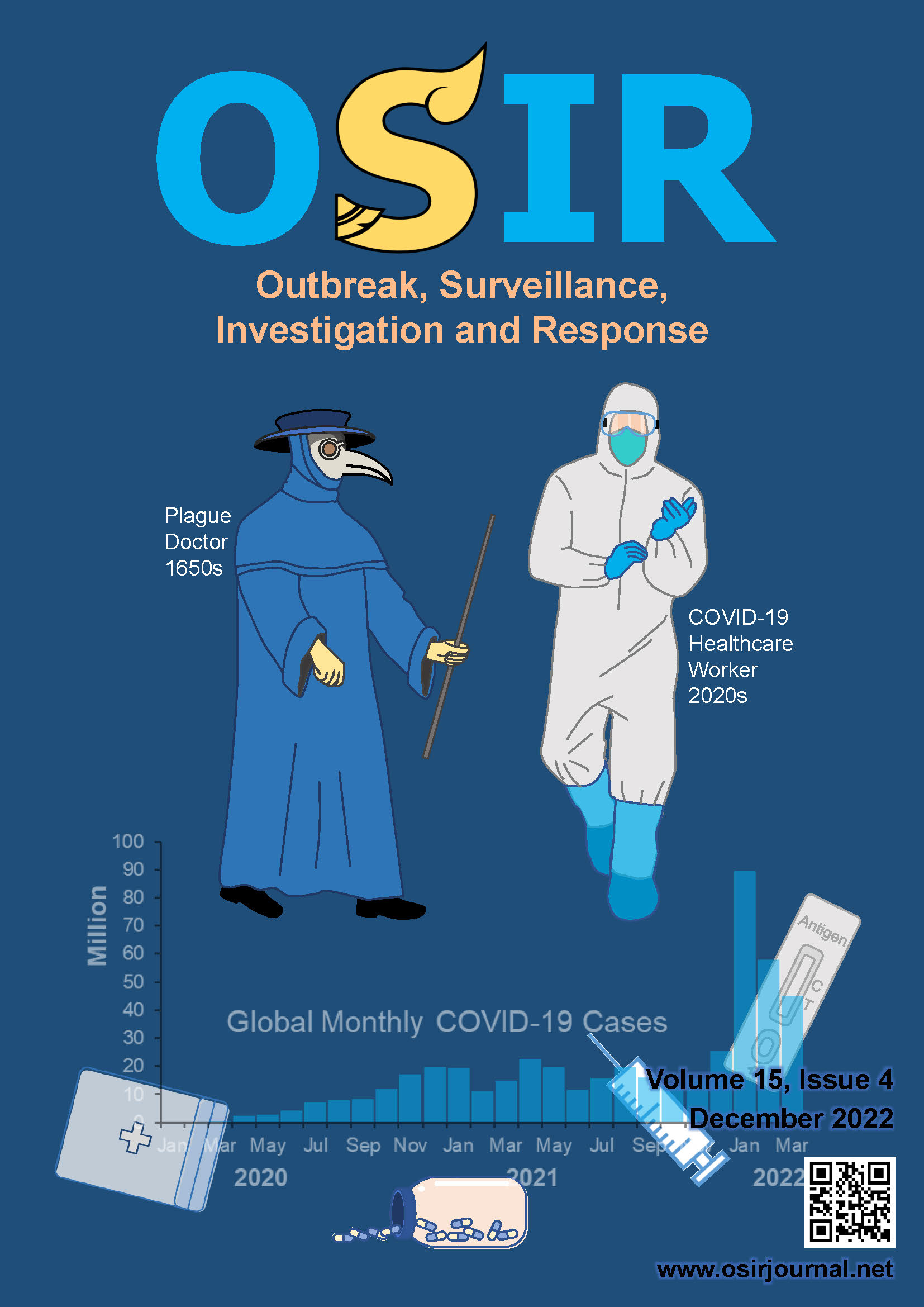Situation and Spatial Analysis of the COVID-19 Epidemic in Business Establishments: Comparison between the Delta and Omicron Variants in Thailand, July 2021–May 2022
DOI:
https://doi.org/10.59096/osir.v15i4.262274Keywords:
COVID-19, spatial autocorrelation, business establishments, ThailandAbstract
COVID-19 outbreaks in business establishments cause a stagnant economy. In Thailand, the COVID-19 situation in business establishments has never been investigated. This study aims to (1) describe the situation and (2) compare characteristics, including spatial patterns, of COVID-19 cases in business establishments between the Delta (July–December 2021) and Omicron (January–May 2022) predominant periods. A cross-sectional study was conducted using secondary data extracted from the Department of Disease Control’s database, which was linked to listed company and factory databases. The study population included all reported COVID-19 cases. The proportions of case characteristics between the delta and omicron dominant periods were compared using Pearson’s Chi-square test. Spatial autocorrelation was tested using Moran’s I statistics. During July 2021–May 2022, 443,448 COVID-19 cases were reported in business establishments. The proportions of cases in factories and construction camps decreased from 41.3% and 6.7% in the Delta dominant period to 14.4% and 1.7% in the Omicron dominant period, respectively. A high number of cases occurred in businesses operating food production, wholesale/retail, transportation, and accommodation. Clustering patterns were evident in the central and eastern regions of Thailand where many business establishments are located. Public health agencies should promote organizational COVID-19 prevention measures and increase worker’s awareness in high-risk industries.
References
Cucinotta D, Vanelli M. WHO declares COVID-19 a pandemic. Acta Biomed. 2020 Mar 19;91(1):157–60.
COVID-19 Coronavirus pandemic [Internet]. Dover (DE): Worldometers; 2022 [cited 2022 Jul 24]. <https://www.worldometers.inf/coronavirus/>
World Health Organization Thailand. Thailand responding to the novel coronavirus [Internet] Nonthaburi: World Health Organization Thailand; 2020 Jan 13 [cited 2022 Jul 24]. <https://www.who.int/thailand/news/detail/13-01-2020-thailand-responding-to-the-novel-coronavirus>
Satdhabudha A, Chaiyakulsil C, Sritipsukho P, Sinlapamongkolkul P, Chaumrattanakul U, Tangsathapornpong A, et al. Epidemiological and clinical characteristics of pediatric COVID-19 in the tertiary care System in Thailand: comparative Delta and pre-Delta era. Mediterr J HematolI Infect Dis. 2022 May 1;14(1):e2022044. doi: 10.4084/MJHID.2022.044.
World Health Organization. Severity of disease associated with Omicron variant as compared with Delta variant in hospitalized patients with suspected or confirmed SARS-CoV-2 infection. Geneva: World Health Organization; 2022 [cited 2022 Jul 24]. 20 p. <https://www.who.int/publications/i/item/9789240051829>
Division of Occupational and Environmental Diseases. COVID-19 in the business establishments. Nonthaburi: Division of Occupational and Environmental Diseases, Department of Disease Control; 2022 [updated 2022 Jul 24; cited 2022 Jul 24].<https://ddc.moph.go.th/doed/pagecontent.php?page=739&dept=doed>. Thai.
Department of Employment. Thailand standard industrial classification 2009. Bangkok: Department of Employment, Ministry of Labour; [cited 2022 Jul 24]. 503 p. <https://www.doe.go.th/prd/assets/upload/files/vgnew_th/d8a88846bfef391bbf9602fe0ba18d1b.pdf>. Thai.
Anselin L. Local indicators of spatial association—LISA. Geographical Analysis.1995;27(2):93–115. doi:10.1111/j.1538-4632.1995.tb00338.x.
Jackson MC, Huang L, Xie Q, Tiwari RC. A modified version of Moran's I. Int J Health Geogr. 2010 Jun 29;9(1):33. doi: 10.1186/1476-072X-9-33.
Bouzid D, Visseaux B, Kassasseya C, Daoud A, Femy F, Hermand C, et al. Comparison of patients infected with delta versus Omicron COVID-19 variants presenting to Paris emergency departments: a retrospective cohort study. Ann Intern Med. 2022 Jun;175(6):831–7. doi: 10.7326/M22-0308.
Wrenn JO, Pakala SB, Vestal G, Shilts MH, Brown HM, Bowen SM, et al. COVID-19 severity from Omicron and Delta SARS-CoV-2 variants. Influenza Other Respir Viruses. 2022 Sep;16(5):832–6. doi: 10.1111/irv.12982.
Nyberg T, Ferguson NM, Nash SG, Webster HH, Flaxman S, Andrews N, et al. Comparative analysis of the risks of hospitalisation and death associated with SARS-CoV-2 omicron (B.1.1.529) and delta (B.1.617.2) variants in England: a cohort study. Lancet. 2022 Apr 2;399(10332):1303–12. doi: 10.1016/S0140-6736(22)00462-7.
Royal Thai Government. Ministry of Public Health promotes "bubble and seal" to successfully control COVID-19 in 2,861 factories [Internet]. Bangkok: Royal Thai Government; 2022 Jun 30 [cited 2022 Aug 20]. <https://www.thaigov.go.th/news/contents/details/56373>. Thai.
Prime Minister's Delivery Unit. What is “Factory Sandbox”? Why is it important? Bangkok: Prime Minister's Delivery Unit; c2020 [cited 2022 Jul 24]. <https://www.pmdu.go.th/factory-sandbox-%E0%B8%84%E0%B8%B7%E0%B8%AD%E0%B8%AD%E0%B8%B0%E0%B9%84%E0%B8%A3%E0%B8%97%E0%B8%B3%E0%B9%84%E0%B8%A1%E0%B8%88%E0%B8%B6%E0%B8%87%E0%B8%AA%E0%B8%B3%E%B8%84%E0%B8%B1%E0%B8%8D/>. Thai.
Murti M, Achonu C, Smith BT, Brown KA, Kim JH, Johnson J, et al. COVID-19 Workplace Outbreaks by Industry Sector and Their Associated Household Transmission, Ontario, Canada, January to June, 2020. J Occup Environ Med. 2021 Jul 1;63(7):574–80. doi: 10.1097/JOM.0000000000002201.
Walshe N, Fennelly M, Hellebust S, Wenger J, Sodeau J, Prentice M, et al. Assessment of environmental and occupational risk factors for the mitigation and containment of a COVID-19 outbreak in a meat processing plant. Front Public Health. 2021 Oct 27;9:769238. doi: 10.3389/fpubh.2021.769238.
Gunther T, Czech-Sioli M, Indenbirken D, Robitaille A, Tenhaken P, Exner M, et al. SARS-CoV-2 outbreak investigation in a German meat processing plant. EMBO Mol Med. 2020 Dec 7;12(12):e13296. doi: 10.15252/emmm.202013296.
Masotti F, Cattaneo S, Stuknytė M, Pica V, De Noni I. Transmission routes, preventive measures and control strategies of SARS-CoV-2 in the food factory. Crit Rev Food Sci Nutr. 2022; 62(17):4821–31. doi: 10.1080/10408398.2021.
Baek K, Kim SH, Park C, Sakong J. Preventive measures against COVID-19 in small- and mid-sized enterprises from an early stage of the epidemic in Daegu and Gyeongsangbuk-do. Saf Health Work. 2022 Sep;13(3):294–301. doi: 10.1016/j.shaw.2022.06.001.
Researcher. COVID-19 vaccination progress in Thailand 2022 [Internet]. [place unknown]: Researcher Covid Tracker; [updated 2022 Mar 5; cited 2022 Oct 26]. <https://covid-19.researcherth.co/vaccination>. Thai.
Frommert H. Population Density of Thailand 2022 [Internet]. Malchow (DE): Geo-Ref.net; [updated 2022 Mar 30; cited 2022 Oct 26]. <http://www.geo-ref.net/ph/tha.htm>
Downloads
Published
How to Cite
Issue
Section
License

This work is licensed under a Creative Commons Attribution-NonCommercial-NoDerivatives 4.0 International License.









